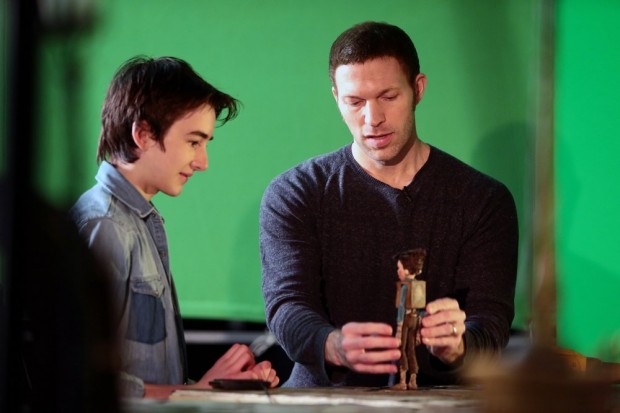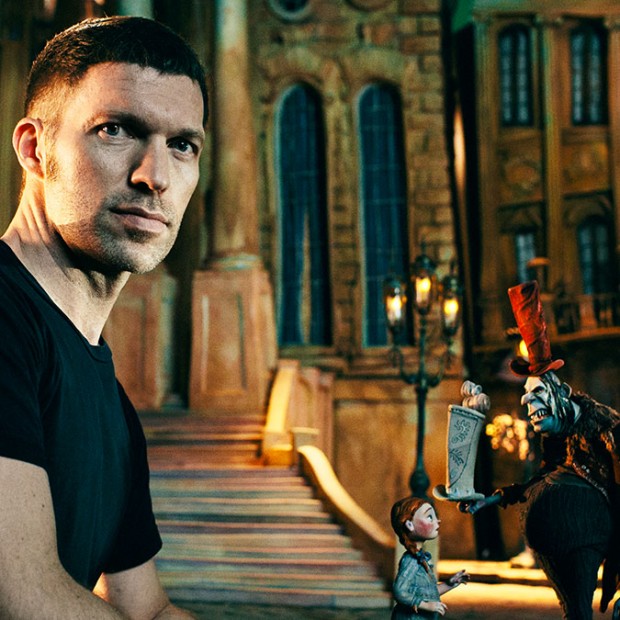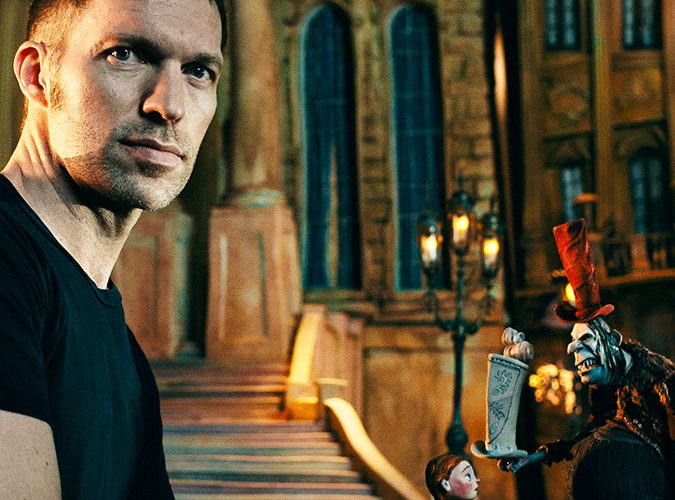
Sharing responsibilities of CEO and lead animator, Travis Knight juggles many balls in the air at once at his Portland-based animation studio, Laika. Upon the release of their third film, The Boxtrolls — which I said in my review has a “virtuous, universal message of fitting in regardless of circumstances and lavish, ornate design making for an enlightening ride” — Knight took some time out of his schedule to discuss the project.
We talked about their approach when it comes to picking material, marketing this latest film, how his tasks balance themselves out, the advantages and disadvantages of their home base, what a “normal day” is like, the future of animation, and more. Check out the conversation below and stay tuned this week for our discussion with the directors of The Boxtrolls.
The Film Stage: Your three features thus far at Laika, even though they are from different source material and directors, they all feel in the same vein — a bit darker and more daring than most normal animation. Can you talk about how conscious of a decision that is when deciding your next project?
Travis Knight: Well, I think what the films share in common is they definitely have strands of the same DNA. That goes to our approach and our philosophy, which goes back to the kinds of films that we loved growing up, what we think is the best kind of filmmaking, which is really dynamic storytelling. You have an artful balance of darkness and light and you see that in the films that we’ve made to this point, where we don’t want to have a house style. We don’t want things visually or aesthetically to look the same. We don’t want them to cover the same kinds of thematic ground. What we do want to have is dynamic storytelling. So Coraline was kind of a dark modern fairytale. Paranorman was this coming-of-age comedic thriller and Here Be Monsters [aka The Boxtrolls] is our first period piece, a Dickensian coming-of-age fable. By being able to explore these different ideas in different visual aesthetics but also having layers of metaphor within the storytelling, I think we’re able to explore things and themes that are more challenging and a little bit richer, more though-provoking. That gets to the core of what we do.
You’re the CEO of the company, so I’m curious how much of a hand do you have in the marketing? These projects take so long to complete because they are so meticulous. I believe you released a teaser last summer, over a year ago, and that’s rare. The way the teasers were handled did a great job of not displaying the story yet and just getting you enticed with the characters. Can you talk about that process?
Yes, we try and bring the same level of thought and creativity and innovation to the marketing of the films as we do to the films themselves. When we put out our first teaser last summer what we were trying to communicate to the audience is how a Laika film experience is an experience for another animation film or another kind of film. We did that in our first few teasers in a two-fold manner: to show the kinds of films we make, the kinds of themes we explore — which we showcased in our first teaser where we talked about what makes a family, hitting on an issue that was potentially provocative, which we found out by the reaction of certain people, but we felt got to the core of the kind idea of what we’re trying to explore, so this was the core theme of the movie. With the second teaser, we show how we make it. This is another aspect of why I like the film, because it’s a hand-crafted thing, it’s a work of art. So we did that behind-the-scenes trailer where you see all these things coming together and then you finally see in the end of the trailer how it works in the film. Those two pieces you see why a Laika film is unique. We explore different ideas that are a little unusual for an animation and we do it in a way that’s also unusual.
Being based near Portland and outside of Hollywood’s radar possibly, what are some advantages and disadvantages of the location?
Yeah, Portland is an interesting place. It’s kind of this culmination of this frontier watering hole and an urban center. So I think that does help to inform the culture at Laika. Portland is a weird place and the kind of people that are drawn to Portland are perfect employees for Laika. You know, our director Tony calls Portland “Burning Man in the off-season.” That’s kind of an interesting summation of the place. So you have these people at Laika, which I sort of see as the island of misfit toys, these people that have these unusual skills and have these strange passions and yet when we get them all together in this community, collectively they can do things that none of us individually can imagine. It’s just a really strange, unusual, and potent combination of skill sets and passions.
I think by being removed from a central film hub like Hollywood or New York or San Francisco, or something like that, it’s both advantageous and it’s got its challenges. Not having access to the experienced talent that you would typically find in one of those places makes it difficult, but by being removed from it, we’re able to develop our own culture entirely removed from all the different kind of influences you would have in a place that has a more robust film environment. So, I think it’s good and bad but I think on a balance, it’s a positive thing because we have developed our own culture and I think you can see that in the kinds of film.
Sharing responsibilities as the CEO and lead animator, can you walk me through that balance and a normal day, if there was ever a normal day?
It’s definitely an unusual thing when I step back and take a look at the different aspects of my job. On the one hand, being an animator and an artist, oftentimes you are directly connected with the work, but you can run the risk of focusing on things too granularly. You can lose sight of the big picture in favor of the minutia. You see it happen all the time. As an executive, as the guy steering the company, it’s all big picture. It’s all about where to do you direct the company, what kinds of films are we going to make. You’re always thinking about the big idea, the big picture. I think that any executive running a company that creates art, the danger there could be losing sight of what it’s all about, which is creating these works of art. By having a foot in each world, I think it makes me better in the other. As an artist, I have to focus on the big picture. As an executive, I have to never lose direct connection with the art. So I think the one thing makes me better at the other. It’s unusual, no doubt about it. I’ll be in a board meeting or in a marketing discussion and run out to stage and crank out a few frames over half-an-hour and then go right back into something else and try to steal away time where I can actually animate and create something and then go back and run the company. It’s a really weird to spend your day, but I over the years I’ve sort of figured out how to balance.

Boxtrolls, I saw, you were thinking about making almost a decade ago. When was the exact moment that you knew it was going to be your next movie?
Laika has been around for almost ten years and the first project we took on to develop into a film was Coraline. The second project that we started developing was Here Be Monsters written by Alan Snow which became The Boxtrolls. These things have a long and winding road to get made, if they ever get made. Sometimes it’s impossible to crack one of these things. So Boxtrolls, it was a tricky thing to extract a film story out of this 550 some-odd page tome written by Alan Snow. To really get to the core 90-minute story that you can tell in a film was a tricky thing. So when you think about the development of it, the majority of the time it’s slow cooking in a corner with just a handful of people trying to figure out how to crack the core story. Once you do that then you start coming up with the designs, the storyboards, and everything else. The longest process was really trying to get the film story out of that book. That’s kind of led to that long process. It’s not unusual, that can happen, but ultimately we felt like we had something that had something deeply personal to say, to the filmmakers but also give us an opportunity to explore bigger societal issues. That’s when we felt like we had something special.
With your other colleagues in the field, what do you see as the next 10-15 years of animation or even beyond? What do you see changing for the better or the worse?
Well, broadly, I think the industry is going through an interesting period right now. Part of that is driven by the fragmentation of the audience. People have more opportunities for different kinds of entertainment then they ever had before, between mobile entertainment and things on their phone or their iPad or things on the internet or whatever. The main form of entertainment isn’t just at the multiplex anymore. They have other options. So there’s different ways as an industry we’ve tried to combat that to varying metrics of success. I think that right now when you look at what defines the film industry, it’s largely reboots and sequels and prequels and remakes and all that sort of thing where old presents are rewrapped and offered up as new gifts. I think in the short term that can be beneficial for the corporation, but in the long term we’re really damaging ourselves as an industry and to the future of film. That’s why I think we, as individual filmmakers and independent companies, have to push really hard to try and tell unique, interesting, and individual stories and really champion individual voices. I do think that becomes more challenging as we move forward and these things consolidate and we see that audiences flock to these sorts of things. It’s harder to make the kind of noise necessary to get people to take a chance on an individual story or a unique voice, but I also think it’s fully necessary. Looking forward, it’s difficult to imagine. I don’t know. Who knows where it goes from here? All I know is that for us, from our perspective, we’re going to keep doing what we’ve been doing, which is try and tell really thought-provoking and emotionally rich stories in an interesting visual way and to take the medium places where it’s never been before. Hopefully audiences will go along for the ride.
The Boxtrolls hits theaters on Friday, September 26th.

